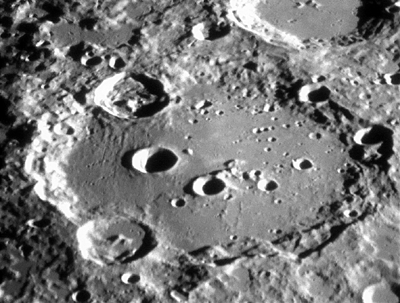Clavius crater

Clavius crater. Image: Chabot Space & Science Center, 20-inch refracting telescope.
Clavius is the third largest crater on the visible near side of the Moon and also one of the oldest lunar craters. Clavius measures about 225 kilometers (140 miles) across and was formed by an asteroid impact some 4 billion years ago. Though it is well-preserved, Clavius shows its age by the many smaller craters within it formed by impacts that happened later.
Clavius is large enough to be seen with the unaided eye. One or two days
after the Moon's first quarter phase, it is noticeable as a notch in the terminator – the day-night separating
line – in the Moon's southern highlands.
Clavius lies south of the prominent crater Tycho at lunar coordinates 58.4° S 14.4° W. It is named after the German
mathematician and astronomer Christopher Klau (1538–1612), whose Latinized name was Christop Clavius.
Clavius and 2001: A Space Odyssey
In both the film and novel versions of 2001: A Space Odyssey, Clavius is the site of a lunar settlement known as Clavius Base. Most of the Base is located underground. It is to here that Dr. Heywood Floyd goes to learn more about the discovery of an alien artifact referred to as TMA-1 (Tycho Magnetic Anomaly 1) at the nearby crater Tycho. Following his meeting with officials at Clavius, Floyd departed for Tycho in a Moonbus.


